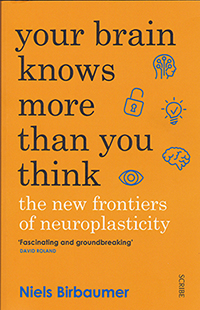
Your Brain Knows More Than You Think - the new frontiers of neuroplasticity
Niels Birbaumer (Scribe 262 pp)
Lamenting how society ascribes ‘immutability’ to our brains, psychologist and neurobiologist Niels Birbaumer sets out to explain how the latest brain-machine interface (BMI) technology can help address a range of severe conditions, and in so doing mounts a strong case against euthanasia.
While he may be just the latest author to explore neuroplasticity, “the virtually limitless capacity of the brain to remould itself,” he takes a different, i.e. more technological, tack to the likes of the great Norman Doige (The Brain that Changes Itself, and The Brain’s Way of Healing).
The main difference is the use of BMI, which in various forms creates a ‘neurofeedback’ loop in a series of steps, from the brain to MRI signal reception, thence brain-image transfer and signal analysis by computer program, transfer of processed brain activity to the BMI software and finally, feedback of blood flow in the brain.
“This book explains why neither locked-in patients nor those with depression, addictions, or anxiety disorders, and neither hyperactive fidgets nor ruthless psychopaths, are frozen forever in their behavior patterns, immune to any attempt to influence them,” Dr Birbaumer explains.
Unexpectedly, he starts out by recounting how he worked to change his own brain, and as a result the anti-social behavior that had seen him join a youth street gang in Vienna and face arrest for stabbing a rival with scissors.
“Brains have a tendency to repeat actions they are particularly good at,” he writes, “without the involvement of the conscious mind to consider the possible consequences of those actions.”
Lucky to avoid prison, he finished school and went off to university studies in London.
Noting that the brain “desires effects that it assesses as emotionally positive,” and that “it is open to anything as long as it achieves a desired effect”, he describes his team’s clinical work in such fields as dementia, Parkinson’s, stroke, epilepsy, ADHD, mental health issues, behavioural disorders including psychopathy, and more.
Regarding epilepsy, he reports that one-third of adult subjects in one trial became totally seizure-free.
In a timely reference to the debate about state-sanctioned euthanasia, he examines how enhancing neuroplasticity has helped to stabilize, or even boost, the quality of life for patients suffering various conditions that cause the brain to lose control over movement and other functions.
In the case of amyotrophic lateral sclerosis (ALS), many patients are plagued by thoughts of suicide in the early stages of illness, especially doctors who are aware of the coming physical decline but “never previously considered how to deal with this challenge mentally.”
In the chapter “The No Case for Euthanasia”, he writes that his clinic usually refuses requests to help end patients’ suffering: “We do this not out of high-handedness or lack of sensitivity, but because… we know how great the chances are that they can still attain a high quality of life.
“This is because their brain will adapt to receiving only very few eternal stimuli, and by the same token, those stimuli will be experienced as particularly intense and positive, as long as the patient is well cared for.”
As to why neurofeedback is not more widely practiced, he blames the lack of interdisciplinary thinking: “Doctors and neurologists are taught that physical conditions require physical - that is, medical mostly pharmacological) treatment. Psychologists are taught that psychological behavior disorders require mental, and therefore social and psychological, treatment.
“This simple logic seems convincing, but it is wrong…. Many physical diseases of the nervous system, such as epilepsy, often respond better to psychological interventions, while mental and psychological disorders react better to medical treatment (e.g. medication to treat schizophrenia, or ECT for depression).”
The extent of this unfortunate dichotomy is reflected by health insurance companies, which refuse to accept the fluidity of the neuroplastic frontiers.




